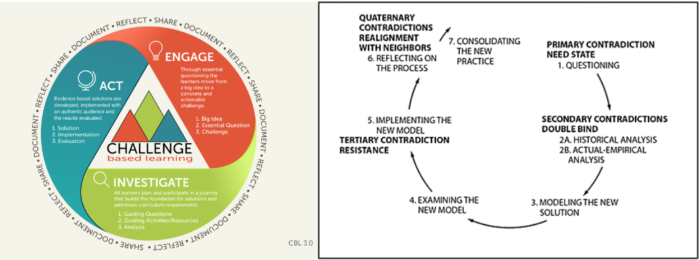Unfinished post-doctoral research project at Post-Graduate Program in Informatics at PUCPR.
Software studio is a pedagogical approach for learning while doing it in practice Interaction Design (CULÉN et al, 2014; BINDER et al, 2009; REIMER, 2003) as well as Software Engineering (HAZZAN, 2002; KUHN, 1998; TOMAYKO, 1996; TOMAYKO, 1991). Inspired by the way architects learn to design in studios — a.k.a. Studio Based Learning (SBL) (LACKNEY, 1999; SCHÖN, 1984, 1987), the software studio approach consists of challenging students with typical professionals tasks which require a lot of autonomous work, such as “design an application for this user”. Students may have a few classes, but most of the time, they are working in their projects. The role of teachers and instructors is to give practical advice as well as demonstrations.
The software studio has been studied in many ways, mostly to justify its aledged advantages in terms of learning outcomes. This is expected from a new pedagogical approach in search for recognition, however, at the moment, 26 years after the first study, the approach seems to have prooved its own applicability (HAZZAN, 2002; KUHN, 1998; TOMAYKO, 1996; TOMAYKO, 1991). The next step for studying the software studio is to look at its reflective practice in a qualitative way, much like Donald Schön did to the architecture studio (SCHÖN, 1984, 1987). Such study can move the research beyond justification, opening possibilities for revealing phenomena which did not rise or were not studied in traditional architecture studios.
This research project is based on a practice study in a software studio from PUCPR called Apple Developer Academy. The program implements the Challenge Based Learning (CBL) educational approach (JOHNSON, 2009, NICHOLS, 2008), which emphasizes applying new technologies to community projects. CBL does not require a software studio, however, the teachers have chosen to follow a combination of CBL with SBL — Studio Based Learning. In addition, Apple Developer Academy welcomes students from any discipline — not just Computer Science or Design related — in order to promote innovation at the boundary of disciplines.
Considering the shared epistemology of Studio Based Learning (SBL) and Challenge Based Learning (CBL) which emphasizes tacit knowledge, this research presents a longitudinal study of their combined practice. Similarly to reflective practice studies (SCHÖN, 1984, 1987), evidence will be collected from recorded and non-recorded observations of everyday interactions between students and instructors at the studio. Differently than reflective practice studies, though, the expansive learning theory will be prefered to interpret evidence. This is done to reveal the creation of new knowledge in software studios, a crucial topic to evaluate the boundary innovation of Apple Developer Academy.
2. Expansive learning
Expansive learning theory provides a broader view for SBL and CBL, connecting them to the constructivist pedagogy pioneered by Lev Vygotsky in Russia. This theory contributed to the constructivist stream with an account of how learning in collaborative practices creates new knowledge, instead of just transmitting or acquiring knowledge (ENGESTRÖM, 2014). It is possible that SBL and CBL promote such kind of learning through their emphasis on solutions, however, the available studies do not present evidence of that (SANTOS, 2016; MALMQVIST, 2015; JOHNSON and ADAMS, 2011; CHEUNG et al, 2011). It is unclear whether SBL or CBL provides the strong conflict of motives which triggers the creation of new knowledge, a major requirement according to the expansive learning theory (ENGESTRÖM, 2014).
The expansive learning theory is, therefore, necessary to uncover contradictions in the learning process, which are absent in SBL or CBL theorizing. SBL studies recognizes the role of paradoxes, uncertainty, and conflict in student learning, however, without questioning their historical origins. CBL studies do not take any material resistance into account, mainly describing actions that fits into the three main steps of the method — engage, investigate, and act. Nothwithstanding, CBL is better structured than SBL and includes a process model which can be compared to the equivalent in the expansive learning theory (Figure 2).

Figure 1 – Challenge Based Learning (NICHOLS and TORRES, 2016) and Expansive Learning models (ENGESTRÖM, 2014)
The juxtaposition of CBL and expansive learning models reveals the contrast between a prescriptive theory and a descriptive theory of learning. The former departs from an idea which must be implemented in the world, while the latter departs from an activity as it is now just to follow its own transformations. The absence of models in SBL may grant it a descriptive status, however, the studies typically forge an account to justify the current norm in design practice.
This research project is based on the premise that SBL and CBL studies can greatly benefit from a descriptive study of the learning process as it happens in practice, including the divergences from the theoretical models and social norms. The expansive learning theory provides a good frame for such a study, with the added benefit of relating the study to strong canons in the learning theory: Lev Vygotsky and his contemporary follower, Yrjö Engeström.
3. Expansive design
Another reason for favoring expansive learning in this project is its recent adaptation to study design practive, originating the subsidiary notion of expansive design (VAN AMSTEL, 2015). Expansive design is the practice of designing with contradictions, in contrast to the reductive design practice of designing without contradictions. The concept has been applied succesfully to study how multidisciplinary teams deal with the contradictions of creating something together. In particular, it shed light on how designers could not get over the contradiction between use value and exchange value, and yet they manage to produce something useful and exchangeable which could also be considered new knowledge (VAN AMSTEL et al, 2015).
In the software domain, this contradiction explains the separation between those who design from those who use software (SUCHMAN, 1994), the division of labour, as well as the dispute for knowledge domains. It can also be related to the commoditization of software and the consequent lack of innovation (QUINTAS, 1994).
The multidisciplinary software studio was created precisely to anticipate this specific contradiction before students enter the industry, so they can learn how to deal with that. Architecture and design studios traditionally emphasized students learning how to “impose a discipline in their work” or how to “think like an architect”, however, the collaborative premise of this particular multidisciplinary studio put instructors and students into conflicts of motives, when they must choose whether to impose or to recede their disciplines from the collaborative work done.
Designing with contradictions is an everyday activity for software studios, even more for multidisciplinary software studios. The expansive learning and expansive design theories provides a framework to collect and anlyse evidence of contradictions in the learning practice of Apple Developer Academy.
4. Research method
This research project is guided by the following research questions:
- What are the inner contradictions of multidisciplinary software teams?
- How students from different disciplines design software despite the contradictions of working together?
- How does innovation rise at the boundaries of disciplines?
These questions will be answered by observing everyday interactions of students and instructors from Apple Developer Academy software studio and also by organizing double stimulation experiments on specific issues. The initial observations will not be recorded and framed, in order to get a glimpse of the social relations crafted in the studio. The style of observation will be participatory to get an inter-subjective understanding of these social relationships. Once some patterns of interaction rise in the conversation with other researchers collaborating with these project, specific observations will be recorded to represent a typical interaction pattern. These recordings will be partly transcribed and annotated according to the codes provided by the expansive learning and design theories. This will roughly follow the Interaction Analysis method (JORDAN and HENDERSON, 1995).
The conflicts of motives observed in the studio will be studied in detail through double stimulation experiments (ENGESTRÖM, 2007). These experiments are not controlled like behavioral psychology experiments, however, they offer a certain degree of direction through the second stimulus. The second stimulus is a tool used by the participant subjects to overcome the contradiction of the first stimulus. The observation of the experiment focus on the expected or unexpected use of this tool, which may reveal the underlying psychological structures created to overcome the struggle.
5. Expected results
This research project will contribute to the Software Engineering literature with a practical account of multidisicplinary software teams, in particular, the description of contradictions implicated in the division of labor. The emergence and demise of disciplinary boundaries will also be linked to these contradictions. In fact, overcoming these contradictions is expected to be the concrete base of the innovations which are deemed to emerge from multidisciplinary work. Verifying this relationship may also represent a contribution to Design literature. Such findings will be thoroughly articulated to extend the expansive design theory of designing with contradictions.
Besides the main contribution to Software Engineering and Design literature, this project will also make a marginal contribution to the field of Education. Discussing Challenge Based Learning and Studio Based Learning in light of the expansive learning theory will strengthen the theoretical underpinnings of these practical learning approaches, making them better integrated with the current research in Education.
References
VAN AMSTEL, Frederick MC et al. Expanding the representation of user activities. Building Research & Information, v. 43, n. 2, p. 144-159, 2015.
AMSTEL, Frederick Marinus Constant van. Expansive design: designing with contradictions. PhD Thesis (Architecture and Design). University of Twente, 2015.
BINDER, Thomas; LÖWGREN, Jonas; MALMBORG, Lone. Introduction–(Re-) Programming Interaction Design. In: (Re) Searching The Digital Bauhaus. Springer London, 2009. p. 1-12.
(COUGHLAN; COUGHLAN, 2002) COUGHLAN, P.; COUGHLAN, D. Action research for operations management. International Journal of Operations and Production Management, 2002, v.22, n.2. Academic Research Library, 2002, p. 220- 240.
CHEUNG, R. et al. Challenge based learning in cybersecurity education. Proceedings of the International Conference on Security and Management, 2011.
CULÉN, Alma Leora; MAINSAH, Henry; FINKEN, Sisse. Design Practice in Human Computer Interaction Design Education.In: ACHI 2014 : The Seventh International Conference on Advances in Computer-Human Interactions, IARIA, 2014.
ENGESTRÖM, Yrjö. Putting Vygotsky to work: The change laboratory as an application of double stimulation. The Cambridge companion to Vygotsky, p. 363-382, 2007.
ENGESTRÖM, Yrjö. Learning by expanding. Cambridge University Press, 2014.

